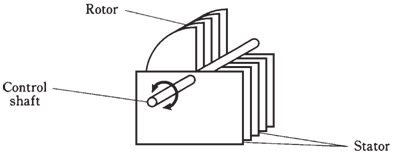Variable capacitors:
Capacitors are varied in the value by adjusting the mutual surface area between plates, or by simply changing the spacing between the plates. The 2 most common types of variable capacitors are the air variable and the trimmer.
Air variables:
By connecting 2 sets of metal plates such that they mesh, and by affixing one set to a rotatable shaft, a variable capacitor is made. The rotatable set of plates is called as rotor, and the fixed set is called as stator. This is the kind of component you may have seen in the older radio receivers, which were used to tune frequency. This type of capacitors is still used in the transmitter output tuning networks. Figure given below is a functional rendition of the air variable capacitor.

Figure-- Simplified drawing of the air-variable capacitor.
Air variables have maximum capacitance which depends on number of plates in each set, and on the spacing between the plates. The common maximum values are 50 pF to about 1,000 pF; minimum values are a few picofarads. The voltage-handling capability relies on the spacing between plates; some air variables can handle several kilovolts together.
Air variables are used at the radio frequencies. They are very efficient, and are nonpolarized, although rotor is generally connected to the common ground (the chassis or the circuit board).